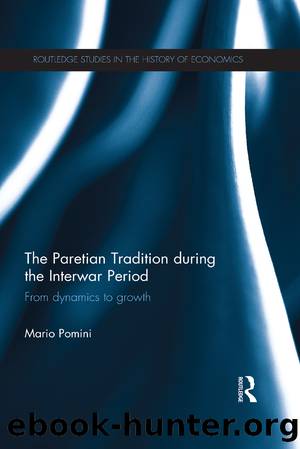The Paretian Tradition During the Interwar Period by Pomini Mario;

Author:Pomini, Mario;
Language: eng
Format: epub
ISBN: 1707434
Publisher: Taylor & Francis Group
General dynamic equilibrium of production and the energy viewpoint of the productive process
Throughout his research, Amoroso remained a nineteenth-century economist who tried to base the scientific claims of the economic investigation on analogies with natural sciences.3 This epistemological project found its most complete expression in the interpretation, in energy terms, of the productive process contained in the text dated 1942. According to Amoroso, the similitude between mechanic and economic phenomena is complete: even in the sphere of production it is possible, keeping into account the interpretative differences which nonetheless exist, to find the principle of energy conservation at work, one of the basic principles of classical physics, in the form of the minimum means principle; with the only difference that while in nature it derives from the experimental evidence but we do not know the origin, in economics it is the intentional outcome of a rational behaviour. We can follow Amorosoâs line of reflection introducing the part on dynamic equilibrium concerning the enterpriseâs behaviour and thus production.
The mathematical nature of the problem concerning the producer is totally analogous to that of the consumer, once the production is made dependent not only on the quantity of the factors used but also on their rate of variation (Lezione XIV. La dinamica dell âimpianto industriale). In this case the total revenue (T) and the total production cost (Î) are represented by the following expressions
T = pz(x,áº)eâit Î = qxeâit [5]
where p represents the price of the product, q that of the productive factor; x in turn, indicates the flow of productive investments and z the quantity of product supplied in a specific temporal interval. It is important to notice how the dynamic element of the model is constituted by the fact that the total revenues do not depend only on the intensity of the investment but also on its variation (áº), exactly as in the case of the dynamic choice of the consumer. The entrepreneurâs aim is to maximize the accumulation of profits within the interval t0 ⤠t ⤠t1,
[6]
In this regard, Amoroso observes,
With this hypothesis we can admit that the producer inspires his action to the principle of maximun return , which thus appears formally analogous to the principle of minimum action. With this fundamental difference: the principle of minimum action represents a law of nature, while the principle of maximum return, expression of the general economic principle of minimum means, represents a principle of conduct.
(Amoroso 1942: 150)
The application of Euleroâs equation leads to the following relation (called by Amoroso, Langrangeâs production equation),
[7]
This equation constitutes a reformulation from a dynamic viewpoint of the condition of optimum static determined by the equality of the marginal revenue, which now depends also on the variation rate of the factor, with the marginal cost. Besides the stationary case, there is a new term, to which Amoroso offers the following interpretation:
[â¦] if the regime is not stationary, the maximum return is conditioned by the forming of a gap between value and marginal cost of production. This
Download
This site does not store any files on its server. We only index and link to content provided by other sites. Please contact the content providers to delete copyright contents if any and email us, we'll remove relevant links or contents immediately.
The Brazilian Economy since the Great Financial Crisis of 20072008 by Philip Arestis Carolina Troncoso Baltar & Daniela Magalhães Prates(121535)
International Integration of the Brazilian Economy by Elias C. Grivoyannis(91443)
The Art of Coaching by Elena Aguilar(52949)
Flexible Working by Dale Gemma;(23254)
How to Stop Living Paycheck to Paycheck by Avery Breyer(19638)
The Acquirer's Multiple: How the Billionaire Contrarians of Deep Value Beat the Market by Tobias Carlisle(12241)
Thinking, Fast and Slow by Kahneman Daniel(12080)
The Radium Girls by Kate Moore(11926)
The Art of Thinking Clearly by Rolf Dobelli(10229)
Hit Refresh by Satya Nadella(9040)
The Compound Effect by Darren Hardy(8814)
Tools of Titans by Timothy Ferriss(8221)
Atomic Habits: Tiny Changes, Remarkable Results by James Clear(8188)
Turbulence by E. J. Noyes(7940)
A Court of Wings and Ruin by Sarah J. Maas(7653)
Change Your Questions, Change Your Life by Marilee Adams(7637)
Nudge - Improving Decisions about Health, Wealth, and Happiness by Thaler Sunstein(7622)
How to Be a Bawse: A Guide to Conquering Life by Lilly Singh(7394)
Win Bigly by Scott Adams(7095)
